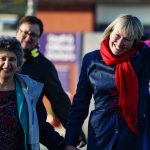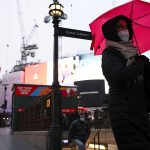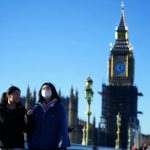We are starting to get data about the spread of Omicron, almost three weeks on from when the first case of the new COVID variant was detected in the UK.
Scientists estimate the number of new cases is doubling in less than two days, with every person with Omicron infecting three to five other people on average.
The latest data from the UK Health Security Agency (UKHSA) suggests that the new variant now accounts for 41% of cases in England and more than one-fifth of cases in Scotland.
The most rapid spread is in London, where almost three-quarters of new cases have S Gene target failure – an indicator used to determine if someone has been infected with Omicron.
Total infections are rising in the capital as a result. More than half (17) of the 25 areas with the highest case rates are in London and the South East.
Lambeth, Wandsworth, Southwark and Sutton have the highest case rates in London – all at least 40% above the UK average for the week ending 10 December.
Professor Lawrence Young, a virologist at the University of Warwick, says that teasing apart the impact of the new variant from Delta is still difficult, but adds that it is “quite possible” that this is early uptick is the result of Omicron infections.
Can the NHS cope?
England’s chief medical officer, Professor Chris Whitty, has warned that “records will be broken a lot over the next few weeks” as Omicron spreads rapidly through the population.
The government’s primary concern is whether these high numbers translate into hospitalisations, as the health service is already under strain from the Delta epidemic and the usual winter surge in demand for care.
We don’t know yet how much pressure the Omicron wave will put on the NHS. Daily admissions in London have already hit their highest level since February 2021, but levels are still fewer than a fifth of their January peak.
Prof Whitty said that it’s “entirely possible” that daily hospital admissions could exceed the record set in January, but added that “it’s very difficult to make definitive views about where the NHS is going to end up in the next four weeks”.
Dr Susan Hopkins, the UKHSA’s chief medical adviser, says it will be a few weeks before we get data on the severity of Omicron and the effectiveness of vaccines.
“The earliest we will have reliable data is the week between Christmas and New Year and probably early January,” she said.
What can we do to slow the spread in the meantime?
Understanding of vaccine protection against Omicron is limited, but early data suggests that boosters offer much higher protection than being double jabbed.
So, the government is pinning its hopes on boosters, offering everyone over the age of 18 the opportunity to book a jab before the end of the year.
The impact of this is already being seen in the vaccine numbers. A record 745,183 booster or third doses were given on 15 December.
However, there is a lag before the impact of boosters will show in infection numbers as it takes a few weeks for immunity to build up and so scientists are advising the government to impose new restrictions in the meantime.
On 15 December, the Independent SAGE group of scientific advisers called for an “immediate circuit break” to curb infections by banning all indoor socialising and reintroducing 10-day isolation for close contacts.
Boris Johnson has opted instead for a stern warning, urging everyone to “think carefully” about socialising at the moment in the hope that people will choose to limit social contact.
Will this be enough?
There are tentative signs that people are taking note in the parts of the country where Omicron is spreading most rapidly.
The average number of face-to-face contacts per adult has fallen from four to 2.5 in the South East in the three months to 7 December. The Midlands and London have also seen numbers fall over this period.
But it is still too early to know whether the prime minister’s warnings will have a material impact on transmission in the run up to Christmas.
The Data and Forensics team is a multi-skilled unit dedicated to providing transparent journalism from Sky News. We gather, analyse and visualise data to tell data-driven stories. We combine traditional reporting skills with advanced analysis of satellite images, social media and other open source information. Through multimedia storytelling we aim to better explain the world while also showing how our journalism is done.






















